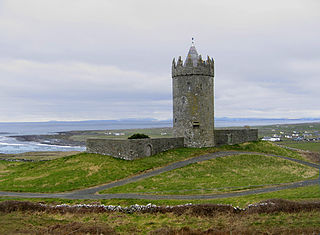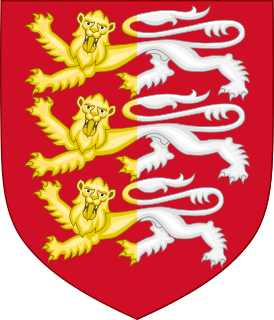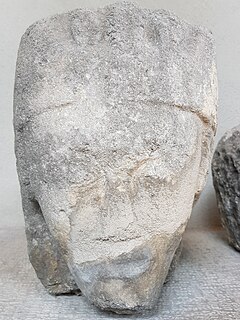
Thomond, also known as the kingdom of Limerick, was a kingdom of Gaelic Ireland, associated geographically with present-day County Clare and County Limerick, as well as parts of County Tipperary around Nenagh and its hinterland. The kingdom represented the core homeland of the Dál gCais people, although there were other Gaels in the area such as the Éile and Eóganachta, and even the Norse of Limerick. It existed from the collapse of the Kingdom of Munster in the 12th century as competition between the Ó Briain and the Mac Cárthaigh led to the schism between Thomond and Desmond. It continued to exist outside of the Anglo-Norman-controlled Lordship of Ireland until the 16th century.

The Dalcassians are a Gaelic Irish tribe, generally accepted by contemporary scholarship as being a branch of the Déisi Muman, that became a powerful group in Ireland during the 10th century. Their genealogies claimed descent from Tál Cas. Their known ancestors are the subject of The Expulsion of the Déisi tale and one branch of their blood-line went on to rule the petty kingdom of Dyfed in Wales during the 4th century; probably in alliance with the Roman Emperor Magnus Maximus.

The name McInerney is of noble Irish origin where it is found in the modern Irish form of Mac an Airchinnigh and in the old and literary forms of Mac an Oirchinnigh and Mac an Oirchindig. The pronunciation of Mac an Oirchinnigh led the name to be sometimes anglicised as McEnherheny in Irish documents from the 16th–19th centuries. The name translates to "son of the erenagh" in Irish, literally meaning "son of the Lord of church lands". Airchinneach may in turn derive from the twin components of air ("noble") and ceann ("head"), therefore meaning a 'noble-head' or 'Lord', denoting its aristocratic status in medieval Ireland. The coat of arms is three red lions passant, and the motto is Veritas, meaning "Truth". In some places, the motto can be found as Vincit Veritas, meaning "Truth Conquers", or "Truth Prevails".
Ollamh Síol Muireadaigh was a hereditary post, held almost exclusively by members of the Ó Maolconaire family, from at latest the 13th century until the 17th century. The Síol Muireadaigh were a dynasty of regional clans, named after King Muiredach Muillethan of Connacht, all of whom lived in north-central Connacht. While many of the ruling chieftains such as the Ó Conchubhair Donn, Ó Conchubhair Ruadh, Mac Diarmata, and Ó Flannagain were descendants of this Muiredach Muillethan, the Ó Maolconaires are of Laiginian, or mythically of Tuatha Dé Dannan stock, although their Milesian pedigrees claim differently. The Laiginians arrived in Connacht in the 3rd century AD from Leinster, conquering the ruling Fir Bolg and Fomorians, and ruling until conquered by the Gael under the Connachta in the 5th century.

Murrough O'Brien, 1st Earl of Thomond was the last King of Thomond, and a descendant of the High King of Ireland, Brian Boru.
Events from the year 1343 in Ireland.
Events from the year 1565 in Ireland.
Domnall Mór Ua Briain, or Domnall Mór mac Toirrdelbaig Uí Briain, was King of Thomond in Ireland from 1168 to 1194 and a claimant to the title King of Munster. He was also styled King of Limerick, a title belonging to the O'Brien dynasty since Brian Boru's annexation of the Norse city in the 10th century.
Mathghamhain Maonmhaighe Ó Briain was King of Thomond during 1360-69.

Donogh O'Brien, 4th Earl of Thomond and Baron Ibrickan, was a Protestant Irish nobleman and soldier. He fought for Queen Elizabeth during Tyrone's Rebellion and participated at the Siege of Kinsale. His long-term objective, achieved after decades, was to obtain an official acknowledgment that County Clare, where his possessions were situated, was part of the Province of Munster, to free it from the jurisdiction of the Connaught government under which it had been placed.
Murrough mac Toirdelbach Ó Briain, Chief of the Name, the Clan Tiege of Aran, fl. 1575 – 1588.
Connor O'Brien, King of Thomond was the second to last King of Thomond.
Mac Fhlannchaidh was the surname of two unrelated Gaelic-Irish families, of Breifne and Thomond.
Aedh Mac Fhlannchaidh was an Irish brehon lawyer and Ollamh of Thomond.

Boetius Clancy or MacClancy was a 16th-century Irish landowner, MP and High Sheriff.
Thomondgate is a district on the northside of Limerick city, Ireland. In times past the district was located at an important portal from the west of Ireland and the then Kingdom of Thomond into the ancient City of Limerick, which was then confined to the Englishtown area of the city. Thomondgate was part of the "Northern" Liberties granted to Limerick in 1216. This area was the border between Munster and Connacht until County Clare, which was created in 1565, was annexed by Munster in 1602. Thomondgate was connected to Limerick by Thomond Bridge over the River Shannon.

Kilmaleery is a civil parish in County Clare, Ireland. It is part of the Catholic parish of Newmarket-on-Fergus.

Killilagh or Killeilagh is a civil parish in County Clare, Ireland. It contains the village of Doolin.

The O'Brien dynasty is a noble house of Munster, founded in the 10th century by Brian Boru of the Dál gCais (Dalcassians). After becoming King of Munster, through conquest he established himself as Ard Rí na hÉireann. Brian's descendants thus carried the name Ó Briain, continuing to rule the Kingdom of Munster until the 12th century where their territory had shrunk to the Kingdom of Thomond which they would hold for just under five centuries.

Toirdhealbhach Mór Ó Briain was King of Thomond (1276-1306) and the main protagonist of Seán mac Ruaidhri Mac Craith's epic Cathreim Thoirdhealbhaigh describing his struggles against the Norman Thomas de Clare.